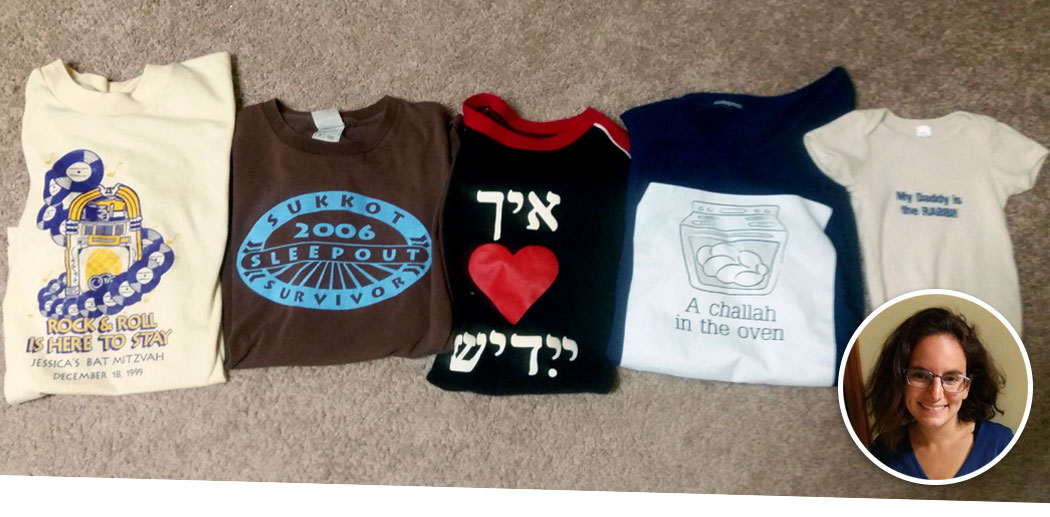
A Jewish Autobiography in T-shirts
T-shirts are often used to mark specific events and occasions: they are party favors and give-aways that signal communal and institutional involvement. The t-shirts in this collection are organized chronologically as I received them and through them it is possible to reconstruct the history of my own Jewish involvement and identity. These t-shirts help to illustrate the way that my life-cycle events and life changes: coming of age, attending college, exposure to new ideas, pregnancy, graduation, etc., have connected me to Jewish institutions and community and have been marked as Jewish moments. The t-shirts in this collection all are readable to some extent by people who were not directly involved in the events or occasions they describe, and yet when I wear or look at them they bear memories and feelings beyond the meaning of the words and images printed upon them. They are material signposts of the way that my life has been shaped by Jewish communal involvement, of my changing Jewish commitments, and of the friends and memories that I have made through Jewish institutions and events.
![]()
I Had a Ball
This T-shirt was a party favor at my Bat Mitzvah on December 18, 1999. The design says nothing about the religious ceremony itself, but instead displays the party’s ‘theme’ (oldies), emphasizing a lighthearted notion of celebration that has become central to this event to many of today’s American Jews. The t-shirt, containing no explanatory information, assumes that the idea of the “Bat Mitzvah” was universally readable in the New Jersey town I grew up in, and that the information that made my Bat Mitzvah exciting and different from all others was not in the ceremony but in the character of its party. I remember seeing friends, Jewish and non-Jewish, wearing this T-shirt and others like it at my public school for weeks after the party, advertising their involvement in a social group while also announcing that participation in Jewish activities was all about having fun.
Sukkot Survivor Sleepout
This T-shirt, advertising the first annual Sukkot Sleepout for the Homeless sponsored by the University of Virginia Hillel in 2007, discretely includes the name of the Jewish holiday and connects it to the social justice issue of providing resources for the local homeless population. The back of the t-shirt includes a list of sponsors, and an announcement that proceeds will go to PACEM, a local volunteer-based organization that provides shelter for the homeless. The aesthetics of the shirt link the Jewish holiday to university traditions of charitable giving and community activism. The shirt looks like any number of shirts that promote charitable giving and community activism on campus. By listing Jewish and non-Jewish organizations and businesses, the t-shirt and the event it describes tie Jewish religious commitment to engagement with the broader community and to improving the world.. For me, the t-shirt reflects a personal journey toward expressing my Jewish identity not only in Jewish spaces as part of religious observance of ethnic-oriented events, but using Jewish identity as an inspiration and a source of support as I interact with the world around me.
Ikh <3 Yiddish
The students at the Steiner summer internship of the National Yiddish Book Center in 2007 designed this t-shirt to represent our newfound passion for studying Yiddish language and culture, and our connections to one another. The front of the t-shirt reads “I Love Yiddish” in Yiddish, and the back of the t-shirt reads “Nakhes Machines,” also in Yiddish characters, playing on the notion that our grandparents and the broader Jewish community took pride and interest in our work. Wearing this t-shirt at my Hillel at the University of Virginia served to separate me from the other (Hebrew-reading) Jews on campus as someone who had a unique interest in Jewish study and self-expression because I cared and wanted to learn about Yiddish language and culture. Yet the heart at the center of the t-shirt makes it universally readable as a self-expression of ethnic pride.
A Challah in the Oven
My mother-in-law mailed me this t-shirt shortly after I announced my first pregnancy. With this t-shirt she laid claim to the very personal experiences of my body’s transformation as a communal event about producing a Jewish child with a specific ethnic identity and heritage: as an Ashkenazi Jew. This t-shirt helped me to see the broader context of my embodied experience as something bound by social and familial expectations, obligations, and joys. With this t-shirt I was able to imagine and advertise the baby growing inside my body as a Jewish one.
My Daddy is the Rabbi
My baby boy wore this onesie on the day of his father’s ordination as a Reform Rabbi. The t-shirt signaled his participation in the event and the visible communal role that he will have as a rabbi’s child. It also made him into a billboard announcing our family’s pride in my husband’s accomplishments – both as a father and as a rabbi.
Wanna See More T-shirts?
Visit exhibitions created by graduate students. More exhibition pages coming soon!


Comments are closed.